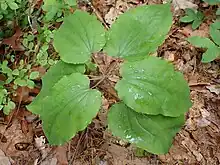| Smilax biltmoreana | |
|---|---|
 | |
| Scientific classification | |
| Kingdom: | Plantae |
| Clade: | Tracheophytes |
| Clade: | Angiosperms |
| Clade: | Monocots |
| Order: | Liliales |
| Family: | Smilacaceae |
| Genus: | Smilax |
| Species: | S. biltmoreana |
| Binomial name | |
| Smilax biltmoreana (Small) J.B.Norton ex Pennell | |
| Synonyms[1] | |
| |
Smilax biltmoreana, common name Biltmore's carrionflower,[2] is a North American plant species native to the south-eastern United States. It is concentrated in the Great Smoky Mountains but with outlying populations in Virginia, North and South Carolina, Tennessee, Kentucky, Georgia, Alabama, and northern Florida.[1][3]
Taxonomy
The species epithet biltmoreana refers to the Biltmore Estate in Asheville, North Carolina, once owned by George Washington Vanderbilt. Vanderbilt sponsored a significant number of botanical studies in the American Southeast in the late 19th and early 20th Centuries.[4]
Description
Smilax biltmoreana is a herb with erect stems up to 60 cm (2 feet) tall. Leaves are egg-shaped to heart-shaped, with wax on the underside but no hairs. Flowers are small and greenish, fruits dark blue.[5]
References
- 1 2 Kew World Checklist of Selected Plant Families
- ↑ USDA, NRCS (n.d.). "Smilax biltmoreana". The PLANTS Database (plants.usda.gov). Greensboro, North Carolina: National Plant Data Team. Retrieved 16 November 2015.
- ↑ Biota of North America Program 2014 county distribution map
- ↑ James R. Troyer. 2006. Botany at Biltmore: an unusual case of private support for science. Journal of the North Carolina Academy of Sciences 122:135-141
- ↑ Flora of North America, Vol. 26 Page 471 Smilax biltmoreana (Small) J. B. Norton ex Pennell